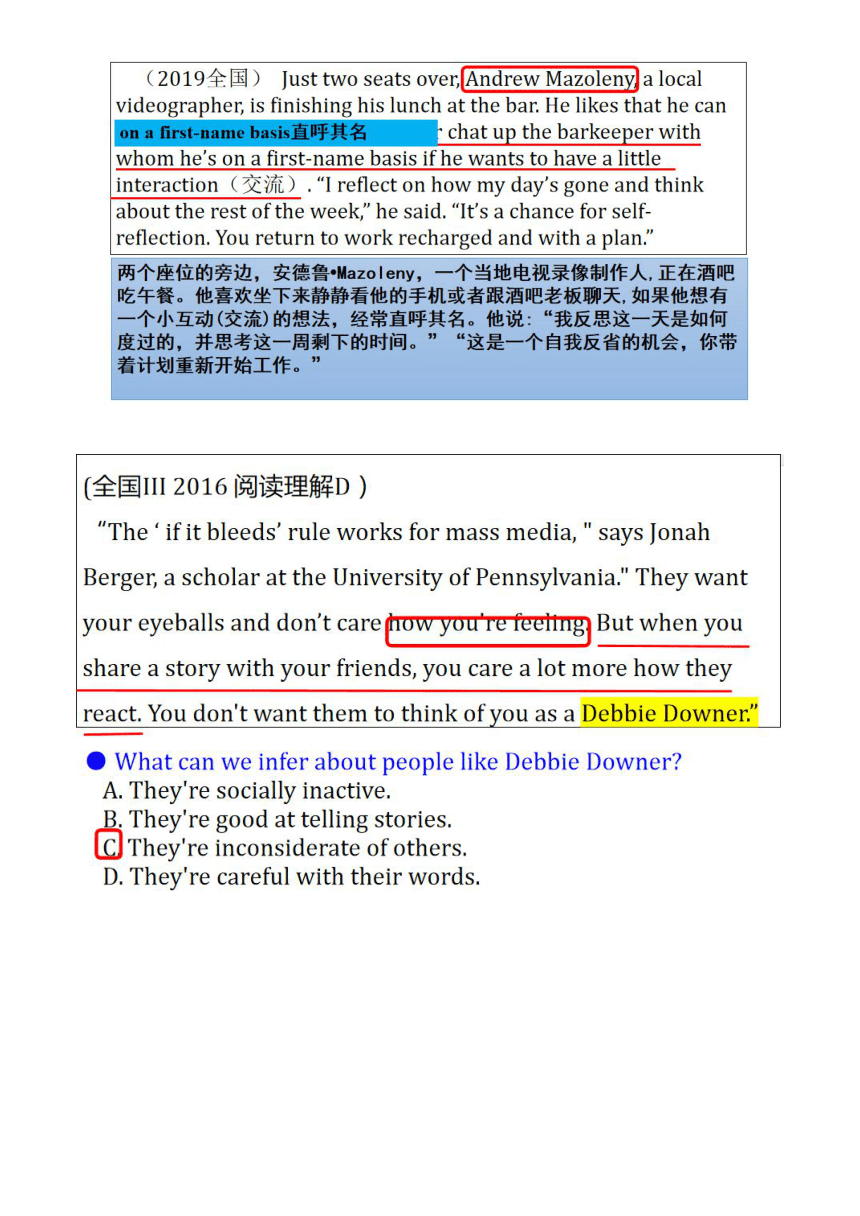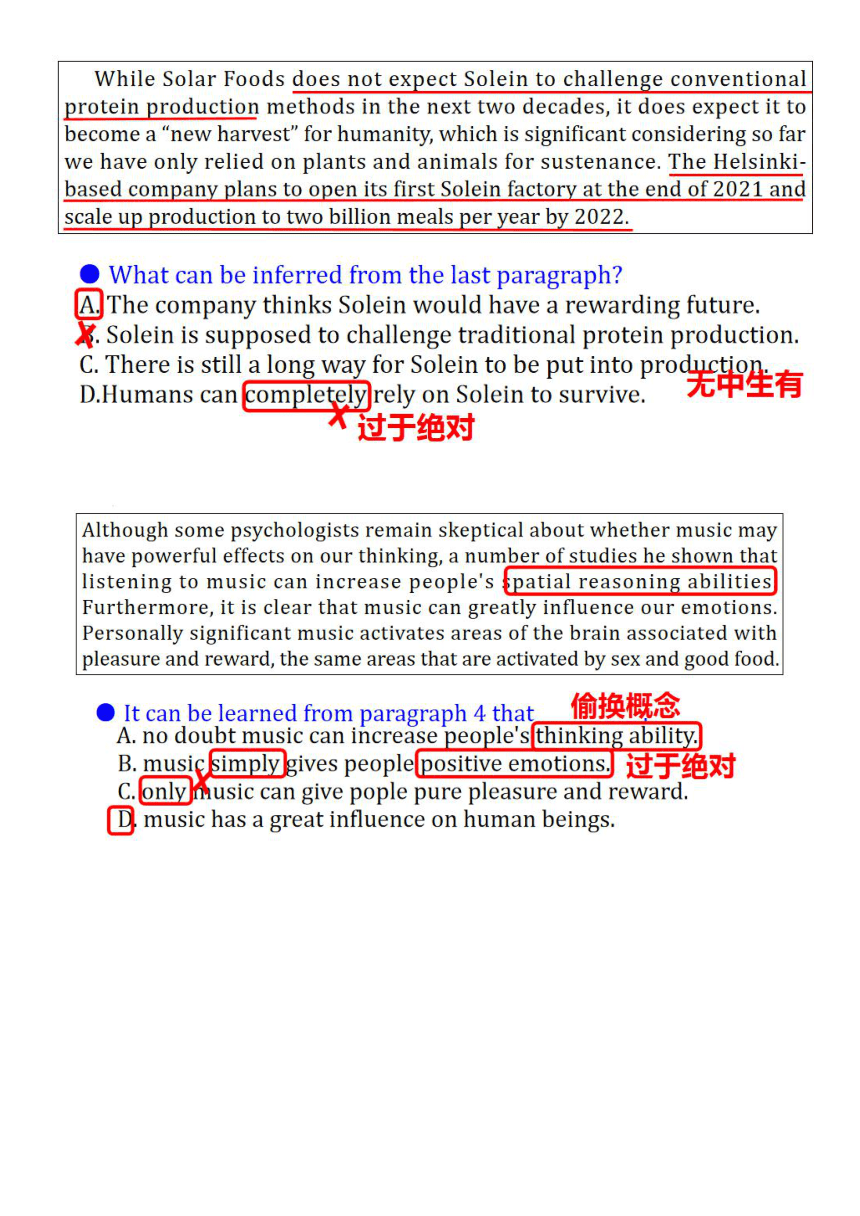2025届高考英语专项复习 阅读理解:推理判断解题方法-学案
文档属性
| 名称 | 2025届高考英语专项复习 阅读理解:推理判断解题方法-学案 |  | |
| 格式 | docx | ||
| 文件大小 | 4.6MB | ||
| 资源类型 | 教案 | ||
| 版本资源 | 通用版 | ||
| 科目 | 英语 | ||
| 更新时间 | 2024-11-05 06:34:38 | ||
图片预览





文档简介
【高考英语】
阅读理解
推理判断解题方法
此类题型要求考生在理解原文的基础上,通过文中细节提示、语义逻辑关系、推测文章隐含的意思,即言外之意。考生除了准确理解相关答题句,应根据文中提供的已知事实为依据,做出合理的推断。
推断题的某个选项往往涉及文中已知的正确信息,以此干扰学生。此类题目的答案通常不能从文中直接得出,必须为推断所得,因此当选项为文中明确指出的表面信息时,大都可马上排除。
干扰项特点
(1)偷换概念:使用了原文出现的词汇或者句式。但不是本题的内容。
(2)扩大或缩小范围:对于原文中的细节或论断的某方面程度进行了扩大或缩小处理。原文中可能出现了almost, all, nearly, more than, normally, usually等词语对文章内容加以限制,干扰选项改变了原文范围;
(3)常识干扰:符合基本常识和我们对社会、生活等方面一些问题的一般看法和认识,但不是文章的内容。
(4)颠倒是非:涉及原文中提及的内容或现象,但选项的意思与原文恰恰相反。
(5)无中生有:凭空捏造原文不存在的细节,形成迷惑和干扰。
(6)推理过头:引申过度,使结论过于绝对化。
正确选项特点
◆是"弦外之音°。是立足原文推断出来的内容,不是直接叙述的具体信息;
◆没有绝对概念的字眼,如only, never, all absolutely 等。因为的推断出来的内容,略有模糊成分,留有余地,通常含有 usually, may, some, might, can, possibly 等词汇.
1.细节推理
细节推断类设问方式:
题干中常出现infer(推断),indicate(象征,暗示),imply(暗示),suggest(暗示),conclude(作出结论),assume(假定,设想)等词。主要设题方式有:
1.It can be inferred from the passage that________.
2.The author strongly suggests that________
3.It can be concluded from the passage that________.
4.The writer/author indicates/implies/suggests that_____
5.What the writer really means is_______.
6.What do we know about___________
7.What we can learn from________
技巧点拨:
1).找到信息源
2).忠实原文,但不是原文
3).理解文章中直接陈述的观点或描述的事实的基础上,领悟作者的言外之意,得出符合作者意愿的结论,即根据作者提供的细节或例证,推断出合理的结论。
(2019·全国卷Ⅱ)“You can use me as a last resort (选择),and if nobody else volunteers,then I will do it.” This was an actual reply from a parent after I put out a request for volunteers for my kids' lacrosse (长曲棍球) club.
2.推断作者观点或态度
观点/态度推断设问方式:
观点态度推断题考查考生是否了解文章作者或者文中人物对某事物所持的观点或者态度。这就要求考生在正确理解文章大意的基础上,对观点或者态度倾向进行分析、识别,关注作者对人物心理或者细节的描写,对文章所交代的人或者事情进行评判。
主要设题方式有:
1.The attitude of the author towards something is__________
2.The writer of the passage seems to think that__________
3.What's the author's opinion on…
4. The writer thought that______.
5. The writer of the text has a _______ attitude towards dangerous sports.
6.What is________’s attitude towards the lives of the indigenous Guianese
7.Which of the following best describe…..
8. ….which would the author agree with
在推断过程中,应特别注意文中作者的措辞,尤其是表达感彩的形容词、副词、动词及所举的例子,推断出作者的弦外之音。
3.推断写作目的/意图
写作意图推断设问方式:
写作意图推断要求考生根据文章的论述,揣测作者的写作意图和写作手法。作者一般不直接陈述自己的意图,而是通过文章所提供的事实,客观地使读者信服某种想法或观点。这就要求考生不但要理解文章的主旨大意,而且要具备对作者阐述问题的方法进行归纳总结和分析的能力。主要设题方式有:
(1) 考查整篇文章的写作目的
What is the main purpose of the author writing the text/ passage/article
The writer of the story wants to tell us that__________
In writing the passage, the author intends to _____.
(2) 考查某处细节的写作意图
The fact... is mentioned by the author to show________
The writer uses the example of…to show that___.
The writer uses the two questions at the beginning of the passage to _____.
…are mentioned in the first paragraph to _____.
What does the author want to say by mentioning the e-reader
从文体类别来推断写作目的
(1) to tell an interesting experience;
to entertain readers: 常见于个人经历或故事类的文章;
(2) to sell a product or a service;
to attract more visitors / readers / audience;
to persuade readers:这种主要是通过对旅游景点﹑报刊杂志﹑影片﹑
电视节目等的介绍来达到写作目的: 吸引更多的游客﹑读者或订户﹑观众
或者推销产品或者服务等;
(3) to explain sth;
to inform readers:多见于科普类﹑新闻报道类﹑文化类或社会类的文章;
(4) to prove /analyze /show /argue :常见于议论文--说服读者接受或赞同某
一观点,倡导某种做法等
4.推断文章出处或读者对象
推断文章出处设问方式:
推测文章的来源或者读者对象要求读者本身要具备一定的常识,这样文章的内容才能与读者本身具备的常识结合起来。有时命题者为了增加试题的难度,特殊的格式或日期可能不出现,这时需要根据文章的题材内容进行推断。如果内容是发布新闻,最可能是出现在报纸上;如果是科普读物,可能是出自科普杂志上。
主要设题方式有:
1.This passage would be most likely to be found in____________
2.The passage is probably/likely taken out of _____________
3.Where does this text probably come from
4.Which section of a magazine is this passage probably taken from
5.The passage is most likely a part of ________.
6.In which of the following would this passage most likely to be found
7.The passage is probably intended for_____
5.推断上下文内容
推断上下文设问方式:
判断文章的后续内容是推理判断题的重要设题方式之一,也是难点。要求考生预测后续文章的内容。
主要设题方式有:
1.The next paragraph would most probably deal with __________.
2.What would the author talk about in the following part
3.What will the writer most probably talk about in the paragraph that follows
4. What is most likely to be discussed in the paragraph that follows
5.The paragraph preceding this one would most likely discuss ______.
1、推测下文的内容:根据作者的思路进行推理, 关注最后一段,尤其是文段结尾
2、推测上文的内容:关注第一段,特别是文段开始的几句话。
3 、如果文章的最后的内容没有有用的信息,那么解题时,就一定要注意根据文章的整体结构来判断。
在推理判断时要牢记以下几点:
1.严格按照阅读材料中所提供的信息进行推理,千万不要掺杂自己的主观想法或经验;
2.如果某选项中的内容是阅读材料的简单重复,那它就不是推论,也就不是正确答案;
3.不选虽在文章中提到,但很片面或不完整的选项。
4. 文中的虚拟语气和情态动词(should, must, may, etc.)往往能流露出作者的弦外之音,这有助于我们确定正确答案;
5.注意作者在文章中的措辞,比如作者在形容词前用了too, excessively, rather则常带有否定的口气;
6.某些过渡词(例如:however, but, on the contrary, what’s more)后面所表达的内容往往能反映作者的观点和态度。
阅读理解
推理判断解题方法
此类题型要求考生在理解原文的基础上,通过文中细节提示、语义逻辑关系、推测文章隐含的意思,即言外之意。考生除了准确理解相关答题句,应根据文中提供的已知事实为依据,做出合理的推断。
推断题的某个选项往往涉及文中已知的正确信息,以此干扰学生。此类题目的答案通常不能从文中直接得出,必须为推断所得,因此当选项为文中明确指出的表面信息时,大都可马上排除。
干扰项特点
(1)偷换概念:使用了原文出现的词汇或者句式。但不是本题的内容。
(2)扩大或缩小范围:对于原文中的细节或论断的某方面程度进行了扩大或缩小处理。原文中可能出现了almost, all, nearly, more than, normally, usually等词语对文章内容加以限制,干扰选项改变了原文范围;
(3)常识干扰:符合基本常识和我们对社会、生活等方面一些问题的一般看法和认识,但不是文章的内容。
(4)颠倒是非:涉及原文中提及的内容或现象,但选项的意思与原文恰恰相反。
(5)无中生有:凭空捏造原文不存在的细节,形成迷惑和干扰。
(6)推理过头:引申过度,使结论过于绝对化。
正确选项特点
◆是"弦外之音°。是立足原文推断出来的内容,不是直接叙述的具体信息;
◆没有绝对概念的字眼,如only, never, all absolutely 等。因为的推断出来的内容,略有模糊成分,留有余地,通常含有 usually, may, some, might, can, possibly 等词汇.
1.细节推理
细节推断类设问方式:
题干中常出现infer(推断),indicate(象征,暗示),imply(暗示),suggest(暗示),conclude(作出结论),assume(假定,设想)等词。主要设题方式有:
1.It can be inferred from the passage that________.
2.The author strongly suggests that________
3.It can be concluded from the passage that________.
4.The writer/author indicates/implies/suggests that_____
5.What the writer really means is_______.
6.What do we know about___________
7.What we can learn from________
技巧点拨:
1).找到信息源
2).忠实原文,但不是原文
3).理解文章中直接陈述的观点或描述的事实的基础上,领悟作者的言外之意,得出符合作者意愿的结论,即根据作者提供的细节或例证,推断出合理的结论。
(2019·全国卷Ⅱ)“You can use me as a last resort (选择),and if nobody else volunteers,then I will do it.” This was an actual reply from a parent after I put out a request for volunteers for my kids' lacrosse (长曲棍球) club.
2.推断作者观点或态度
观点/态度推断设问方式:
观点态度推断题考查考生是否了解文章作者或者文中人物对某事物所持的观点或者态度。这就要求考生在正确理解文章大意的基础上,对观点或者态度倾向进行分析、识别,关注作者对人物心理或者细节的描写,对文章所交代的人或者事情进行评判。
主要设题方式有:
1.The attitude of the author towards something is__________
2.The writer of the passage seems to think that__________
3.What's the author's opinion on…
4. The writer thought that______.
5. The writer of the text has a _______ attitude towards dangerous sports.
6.What is________’s attitude towards the lives of the indigenous Guianese
7.Which of the following best describe…..
8. ….which would the author agree with
在推断过程中,应特别注意文中作者的措辞,尤其是表达感彩的形容词、副词、动词及所举的例子,推断出作者的弦外之音。
3.推断写作目的/意图
写作意图推断设问方式:
写作意图推断要求考生根据文章的论述,揣测作者的写作意图和写作手法。作者一般不直接陈述自己的意图,而是通过文章所提供的事实,客观地使读者信服某种想法或观点。这就要求考生不但要理解文章的主旨大意,而且要具备对作者阐述问题的方法进行归纳总结和分析的能力。主要设题方式有:
(1) 考查整篇文章的写作目的
What is the main purpose of the author writing the text/ passage/article
The writer of the story wants to tell us that__________
In writing the passage, the author intends to _____.
(2) 考查某处细节的写作意图
The fact... is mentioned by the author to show________
The writer uses the example of…to show that___.
The writer uses the two questions at the beginning of the passage to _____.
…are mentioned in the first paragraph to _____.
What does the author want to say by mentioning the e-reader
从文体类别来推断写作目的
(1) to tell an interesting experience;
to entertain readers: 常见于个人经历或故事类的文章;
(2) to sell a product or a service;
to attract more visitors / readers / audience;
to persuade readers:这种主要是通过对旅游景点﹑报刊杂志﹑影片﹑
电视节目等的介绍来达到写作目的: 吸引更多的游客﹑读者或订户﹑观众
或者推销产品或者服务等;
(3) to explain sth;
to inform readers:多见于科普类﹑新闻报道类﹑文化类或社会类的文章;
(4) to prove /analyze /show /argue :常见于议论文--说服读者接受或赞同某
一观点,倡导某种做法等
4.推断文章出处或读者对象
推断文章出处设问方式:
推测文章的来源或者读者对象要求读者本身要具备一定的常识,这样文章的内容才能与读者本身具备的常识结合起来。有时命题者为了增加试题的难度,特殊的格式或日期可能不出现,这时需要根据文章的题材内容进行推断。如果内容是发布新闻,最可能是出现在报纸上;如果是科普读物,可能是出自科普杂志上。
主要设题方式有:
1.This passage would be most likely to be found in____________
2.The passage is probably/likely taken out of _____________
3.Where does this text probably come from
4.Which section of a magazine is this passage probably taken from
5.The passage is most likely a part of ________.
6.In which of the following would this passage most likely to be found
7.The passage is probably intended for_____
5.推断上下文内容
推断上下文设问方式:
判断文章的后续内容是推理判断题的重要设题方式之一,也是难点。要求考生预测后续文章的内容。
主要设题方式有:
1.The next paragraph would most probably deal with __________.
2.What would the author talk about in the following part
3.What will the writer most probably talk about in the paragraph that follows
4. What is most likely to be discussed in the paragraph that follows
5.The paragraph preceding this one would most likely discuss ______.
1、推测下文的内容:根据作者的思路进行推理, 关注最后一段,尤其是文段结尾
2、推测上文的内容:关注第一段,特别是文段开始的几句话。
3 、如果文章的最后的内容没有有用的信息,那么解题时,就一定要注意根据文章的整体结构来判断。
在推理判断时要牢记以下几点:
1.严格按照阅读材料中所提供的信息进行推理,千万不要掺杂自己的主观想法或经验;
2.如果某选项中的内容是阅读材料的简单重复,那它就不是推论,也就不是正确答案;
3.不选虽在文章中提到,但很片面或不完整的选项。
4. 文中的虚拟语气和情态动词(should, must, may, etc.)往往能流露出作者的弦外之音,这有助于我们确定正确答案;
5.注意作者在文章中的措辞,比如作者在形容词前用了too, excessively, rather则常带有否定的口气;
6.某些过渡词(例如:however, but, on the contrary, what’s more)后面所表达的内容往往能反映作者的观点和态度。
